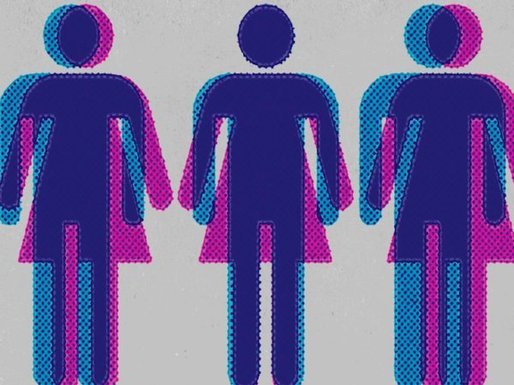The society around us is rapidly changing, and terms and phrases are coming up faster than most can keep up with them.
While some are easy to dismiss as nothing more than a passing fad, there are other terms that are quickly making their importance known and it is essential that the common people know more about them.
Because we no longer live in a simple world where a man marries a woman, has 2.5 kids and a house. We no longer live in a world where gender roles and parameters are so strictly defined and upheld that anyone doing something different is seen as some kind of black magic since of course, that person would be mad to do something different from societal norms.
Two terms that are raising in their frequency of being used are ‘gender neutral’ and ‘gender-fluid’. But as with everything new, people are extremely confused as to which means what and many times either use them interchangeably or completely misunderstand the meaning.
Thus, this is an attempt to demystify both the terms and what all they incorporate:
Gender Neutral
In order to make it as clear and simple to understand, I will use the 5W1H format to help you all take in the information presented-
What-
Gender neutrality simply means an ideology wherein a person avoids using distinguishing gender terms like male or female, instead opting for gender-neutral terms like ‘they’, ‘them’ and such.
This ideology can not only be applied in daily language but is also encouraged to be incorporated into policies and various social institutions so that discrimination based on gender can be avoided.
Where-
It is unknown where exactly the phrase ‘gender neutral’ comes from, but in the past decade, it has surely established itself as an important phrase across nations and countries.
Although its introduction in the Indian society has been very recent, it has intrigued many people and is especially being used as a good parenting method, wherein parents are encouraged to use gender-neutral clothing, room colours, and toys in order to not conform their children to the strict societal norms.
When-
The issue of when to use the term ‘gender-neutral’ is not that complex, as it is not the phrase itself to be used as much as it is adjusting the language and writing to not cement gender roles further.
Also, gender-neutral terms can be used when in the company of genderqueer or non-binary people, in simpler terms, people who do not identify by the mainstream genders. This can include people who are third sex, transgender, intersex and more.
Why-
There are many reasons why one should adopt the ideology of being gender-neutral, because for centuries and millennia now, certain groups and identities have been kept hidden from society at large.
Not recognized by either the society or the govt. they have been forced to take on one of the two mainstream genders.
With this ideology, we can widen our circle to accept these other identities too along with also breaking the strict limitations that each of the mainstream genders brings with them.
Who-
Many think that gender neutrality is something that is the problem of only feminists and those of genderqueer people.
But as per Raoul Festante, author of the book “An Introduction to the Theory of Gender-neutral Language”, the issue of gender-neutral ideology is not something that only affects the feminist movement or those that identify with some other gender or sex.
In fact, it affects the entire society at large and how gender roles can lead to discrimination this includes males too.
How-
A gender-neutral ideology will help to create a more cohesive society that goes above and beyond the mindset of gender altogether instead of having the focus be just on specific genders and their own battles.
Read More: Gender Neutral Greetings To Be Used In Trains In London. Would India Follow Soon?
Gender Fluid
Where ‘gender neutrality’ is an ideology, ‘gender fluidity’ is a way of identifying as neither of the two set genders and instead have a fluctuating gender identity.
What-
People who identify as gender-fluid come under the genderqueer or non-binary category wherein they don’t have a constant gender.
A person who is gender fluid can identify as either a male, female or any of the various non-binary identities at random points of time or in response to a certain event or circumstance.
When-
Considered to be a millennial term, there is no specific timeline of when this term originated.
But it was around 2014 when non-binary identities started to take off and the pride flag for ‘gender fluid’ people was designed by JJ Poole. The flag comprises 6 colours with pink meaning feminity, the white stripe meaning a lack of gender, the purple strip means a mixed gender or being androgynous, the black strip represents all the other genders and the blue stands for masculinity.
Where-
Gender fluidity as a concept is largely open in the West, since as per certain reports, a gender fluid camp in San Fransisco Bay while having been around for about 3 years, was very recently in the news because unlike previous years the enrollment has increased almost 3 times this year.
In India, gender fluidity is not known that much and people are still confused as to what exactly it means, but that is not to say it is entirely unknown.
Who-

A famous gender-fluid figure would be Ruby Rose from the hit show Orange Is The New Black. In an interview with Elle, Rose explained what gender fluidity was to her:
“Gender fluidity is not really feeling like you’re at one end of the spectrum or the other,” she said. “For the most part, I definitely don’t identify as any gender. I’m not a guy; I don’t really feel like a woman, but obviously I was born one. So, I’m somewhere in the middle, which — in my perfect imagination — is like having the best of both s**es. I have a lot of characteristics that would normally be present in a guy and then less that would be present in a woman. But then sometimes I’ll put on a skirt — like today.”
Why-
According to a piece done by CNN, Dot Brauer who is the director of the LGBTQA center in the University of Vermont has said that a person’s gender exists on a spectrum and that your gender identity is the one that feels right to a particular person.
How-
Gender fluidity can be expressed in a number of different ways, through language, use of singular pronouns like ‘they’, ‘them’, ‘their’ and such.
It can also be represented through one’s clothing as well as speech. In an article done by CNN, a gender fluid person speaks of how their speech might change based on what they gender they identify as at that moment.
So this was a slight attempt at clearing up the two terms that are often misused as an alternative to the other. But while gender fluidness and gender neutrality are connected, they mean very different things.
Image Credits: Google Images
Sources: Refinery29, HuffPost, CNN
Other Recommendations:
Is India, “The Country Of Young People” Accepting Towards Different Gender Identities?

































